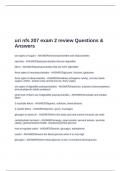uri nfs 207 exam 2 review Questions &
Answers
two types of sugars - ANSWERSmonosaccharides and disaccharides
starches - ANSWERSpolysaccharides that are digestible
fibers - ANSWERSpolysaccharides that are NOT digestible
three types of monosaccharides - ANSWERSglucose, fructose, galactose
three types of disaccharides - ANSWERSmaltose (whoppers candy), sucrose (table
sugars, white) , lactose (only animal source, dairy sugar)
two types of digestible polysaccharides - ANSWERSstarches: amylose (sweet potatoes)
and amylopectin (white potatoes)
what kind of fibers are indigestible polysaccharides - ANSWERSinsoluble and soluble
fibers
3 insoluble fibers - ANSWERSlignans, cellulose, hemicellulose
3 soluble fibers - ANSWERSpectins, gums, mucilages
glycogen is stored in - ANSWERSliver (for body use) and muscle (muscle use only)
carbohydrate functions - ANSWERSenergy, spare protein, prevent ketosis, promote
satiety, gastrointestinal health, maintaining blood glucose
how to regulate carbs - ANSWERSinsulin, glucagon, epinephrine
insulin - ANSWERSlowers the blood glucose when it is very high
glucagon - ANSWERSwhen blood glucose is low, it increases blood glucose
, epinephrine - ANSWERSwhen glucose needed as quick fuel
sources of carbs - ANSWERSmost all from plants except for lactose
top 5 sources in USA of carbs - ANSWERSwhite bread, soda, cookies & cakes,
sugar/syrups/jams, potatoes
glycemic index - ANSWERSthe capacity of a given type of CHO to raise blood glucose
within 2 hours after consumption
RDA carb requirement - ANSWERS130 grams/day
RDA carb recommendation - ANSWERS45-65%
Recommended sugars - ANSWERS< 10%
Recommended fibers - ANSWERS25-30 grams/day
excess sugar from carbs - ANSWERSdental caries, possible compromised dietary
quality
excess fiber from carbs - ANSWERSincreased fluid requirements, decreased mineral
absorption
lactose intolerance - ANSWERSwhen lactase is lacking
hyperglycemia - ANSWERShunger, thirst, excess urine, weight loss, glucose deposits in
tissues, peripheral nerve damage, risk of infections
hypoglycemia - ANSWERShunger, nervousness, irritability, sweating headache, risk of
ketosis and coma
four types of fatty acids - ANSWERSmufa, pufa, saturated, trans
four types of lipids - ANSWERSessential fatty acids, phospholipids, triglycerides, sterols
two types of essential fatty acids - ANSWERSlinoleic = omega 3 and linolenic = omega
6
functions of essential fatty acids - ANSWERScell membranes, immunity, vision, parts of
vital body structures and produce Eicosanoids
functions of phospholipids - ANSWERSemulsifiers, lubricants, membranes
functions of triglycerides - ANSWERSfuel source and storage, insulation/protection, cell
membranes, fat-soluble vitamin absorption




